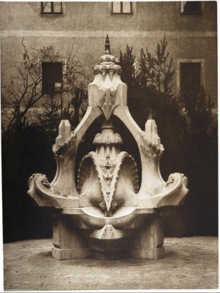Hermann Obrist


Hermann Obrist (23 May 1862 at Kilchberg (near Zürich), Switzerland – 26 February 1927, Munich, Germany)[1] was a German sculptor of the Jugendstil (Art Nouveau) movement. He studied Botany and History in his youth whose influence one can perceive in his later work in the field of applied arts. As a teacher, Hermann Obrist exerted a seminal influence on the rise and subsequent development of Jugendstil in Germany. In 1902 Hermann Obrist and Wilhelm von Debschitz jointly founded a school for design in Munich, where his students included Ludwig Hirschfeld Mack, who later taught at the Bauhaus.
Obrist commissioned his friend August Endell to design his studio in Munich, built in 1897 and destroyed in 1944. Obrist's works included fountains and funerary monuments. He often used concrete for his works.
In addition to being a sculptor he was also a textile artist. Obrist's most famous and influential work was the design for an 1892 embroidered wall hanging called "Cyclamen". It featured a series of elegant, looping curves, described as "whiplash curves", or Peitschenhieb in German, and became a seminal work of the Art Nouveau movement.
References
- ↑ "Hermann Obrist". Biography. Art Directory. Retrieved 23 February 2012.
External links
| Wikimedia Commons has media related to Hermann Obrist. |